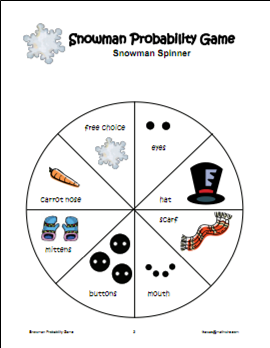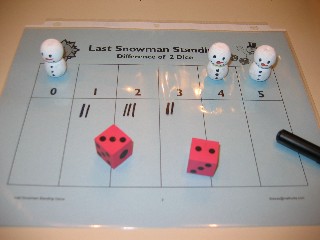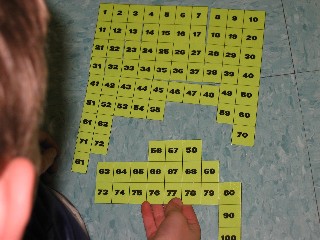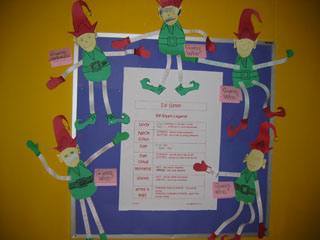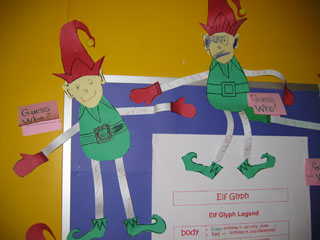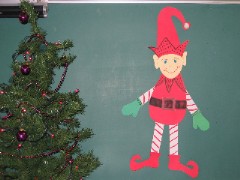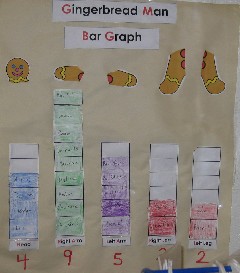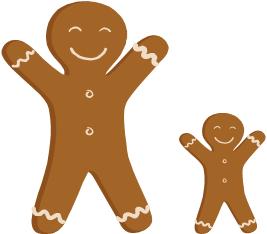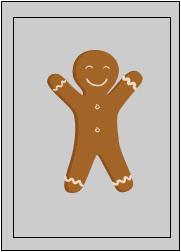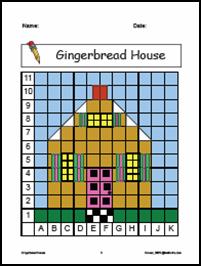This activity is designed as a fun, seasonal data collection activity that introduces students to the probability of a spinner. Although each piece of the snowman is equally likely to be spun, the actual game results are often quite different.
In this game, students spin to win all of the pieces to create the snowman. Students may place a transparent spinner over the spinner template, or use a pencil and paper clip to create a spinner.
Before playing, ask students to estimate how many spins they think they will need to collect all of the pieces for their snowman. Call on students to share both their number of spins and why they think that is a reasonable number. Record these estimates for later discussion.
Give each student a copy of the game mat and insert the mat into a clear sheet protector. Students may then use dry erase pens to draw the pieces as they collect them.
Have students use the Snowman Probability Recording Sheet to collect data on how many spins it takes to get all of the pieces. Insert this sheet in a clear sheet protector for a renewable activity. Be sure to collate the class data and analyze this larger sample to get an approximate number of spins required.
Download the Snowman Probability Game file which includes the game mat, spinner, directions and recording sheet.

Friday, December 16, 2011
Thursday, December 15, 2011
Last Snowman Standing Game
The snowmen face off in this game of addition facts. But beware! A toss of the die may mean the sun melts a snowman. Students practice addition facts as they try to be the last snowman standing because in this game the first person to remove all of his/her snowmen loses the game!
Download the  Last Snowman Standing Game for directions and game mats for three different versions of the game:
Last Snowman Standing Game for directions and game mats for three different versions of the game:
 Last Snowman Standing Game for directions and game mats for three different versions of the game:
Last Snowman Standing Game for directions and game mats for three different versions of the game:- Sum of Two Dice Version to practice addition facts
- Difference of Two Dice Version to practice subtraction facts
- One Die Toss for a simplified version to analyze the probability of a die toss
Data Collection: The directions for each version also include directions for data collection and analysis of the outcomes of the games. Be sure to incorporate these activities, if at all possible, as games offer a highly motivational study in probability. Students love to "play games" to collect data. They're also eager to analyze games so that they learn how the game works and what strategies they can use to improve their odds of winning.
Differentiation: This game offers many opportunities to differentiate the activity. First of all, teachers are able to select from three different versions. Secondly, each teacher should differentiate the game analysis to meet the instructional level of his/her students. Most students can handle the questions with teacher guidance. Older students and talented primary students may be challenged to analyze the game and answer the questions in small groups.
Read about the Last Snowman Standing game on Mathwire.
Read about the Last Snowman Standing game on Mathwire.
Tuesday, December 13, 2011
Hundred Board Puzzles
Students learn the patterns in the hundred board by assembling puzzles. Teachers are able to assess student use of patterns in rows and columns by observing the student at work.
This task is easily differentiated to accommodate the varied levels in a first grade class by changing the number of pieces and the shape of the pieces. Puzzle bags should be sequentially lettered so that students progress through harder versions of the task.
Finally, students are asked to create their own puzzles for classmates to solve.
Download a hundred board template to copy onto card stock and then cut apart to create puzzles.
This task is easily differentiated to accommodate the varied levels in a first grade class by changing the number of pieces and the shape of the pieces. Puzzle bags should be sequentially lettered so that students progress through harder versions of the task.
Finally, students are asked to create their own puzzles for classmates to solve.
Download a hundred board template to copy onto card stock and then cut apart to create puzzles.
Monday, December 12, 2011
Elf Glyph
This Mathwire elf glyph comes complete with legend and downloadable patterns to create your student glyphs. As with all glyphs, teachers should feel free to adjust the legend to best fit the information on your students.
Creating their own glyphs requires students to follow a legend. However, teachers should be sure to also provide opportunities for students to analyze the class glyphs with questions that require them to identify specific information in the glyphs such as:
- Does anyone have a "twin glyph" or someone whose glyph is exactly like yours?
- How many people in the class like to make snowmen?
- Do more people like warm weather or cold weather?
- How many girls like to go sledding?
Friday, December 9, 2011
Gingerbread Graph Ideas
It is very easy to incorporate graphing into a gingerbread man unit. Consider these possibilities to get the creative juices flowing. Remember to include different kinds of graphs as suggested below.
- Gingerbread Info.: As an introduction to the unit, graph how many students have eaten a gingerbread cookie, baked a gingerbread cookie or decorated a gingerbread cookie. [clothespin graph with simple yes/no options]
- Gingerbread Bites: Ask students to take one bite of their gingerbread cookie. Graph or tally how many students bit off the head, the right arm, left arm, right leg or left leg. [bar graph, as shown, or pictograph using pieces]
- Gingerbread Taste Test: Have children taste several different gingerbread cookies, including homemade and store-bought. Ask students to vote for their favorite cookie. [bar graph]
- Gingerbread Man Stories: After reading several different versions of the classic story, ask students to vote on their favorite. [pictograph using book die cuts]
- Gingerbread Unit: At the conclusion of the gingerbread unit, have students vote on their favorite activity. [bar graph]
Thursday, December 8, 2011
Catch the Gingerbread Man Game
For this game, students toss two dice (one regular and one marked A-B-C-D-E-F), form an ordered pair (e.g. B5), then remove the gingerbread man from that space, if there is one. Play continues until the timer rings or until one player has caught 10 gingerbread men. Students love playing the game and they get to practice their coordinate graphing skills in the process.
Coordinate Pairs: This seasonal version of the classic Battleship game provides practice in forming coordinate pairs, identifying the x-coordinate (A-F), then the y-coordinate (1-6) so that spaces are identified as C3 or E6. Hopefully, lots of practice will help students transition to the algebraic ordered pairs (x,y) where x and y are both numbers. Just be certain to reinforce the notion that the x-coordinate (across) comes before the y-coordinate (up or down). The alphabetical cues (across comes before up or down) help some students remember the order.
Download Catch the Gingerbread Man Game which includes game mat, directions and game pieces.
Tuesday, December 6, 2011
Gingerbread Man Problem Solving
Students are asked to use words, pictures and numbers to solve these gingerbread problems:
Gingerbread Bake Sale challenges students to figure out how many different gingerbread men Ruby can make for the holiday bake sale.
Gingerbread Man Chains requires students to calculate how many gingerbread men will be needed to create chains across the bulletin board. Students also need to figure out how many sheets of brown construction paper will be needed for the project.
Creative Extension: Ask students to write original problems that involve the gingerbread man. Encourage them to think of measurement and patterns as well as numbers and operations as they create their word problems. Provide time for students to type in, print out and decorate their problems. Assemble them into a class Gingerbread Man booklet that may be shared with other classes as well.
Gingerbread Bake Sale challenges students to figure out how many different gingerbread men Ruby can make for the holiday bake sale.
Gingerbread Man Chains requires students to calculate how many gingerbread men will be needed to create chains across the bulletin board. Students also need to figure out how many sheets of brown construction paper will be needed for the project.
Creative Extension: Ask students to write original problems that involve the gingerbread man. Encourage them to think of measurement and patterns as well as numbers and operations as they create their word problems. Provide time for students to type in, print out and decorate their problems. Assemble them into a class Gingerbread Man booklet that may be shared with other classes as well.
Gingerbread Man Math
Gingerbread men and gingerbread houses enjoy special popularity around the holidays, but many of these gingerbread activities are timeless and complement literature titles that teachers use at the beginning of school or after the holidays. It's very easy to incorporate mathematics into a study of gingerbread men, and students will enjoy the data collection activities and games while learning math skills and deepening their understanding of important mathematical concepts.
Look through these math activities and add some to your repertoire. Consider broadening the gingerbread math to include measurement, games and problem solving this year.
Check out Mathwire's Gingerbread Man Math collection, part of Mathwire's themed math activities collection.
Monday, December 5, 2011
Gingerbread House Math
Introduce elementary students to coordinate graphing through seasonal coloring activities. This winter Gingerbread House activity requires students to use the grid code and crayons or markers to create a gingerbread house on a blank 11x11 grid. The use of letters on the horizontal axis and numbers on the vertical axis introduces young students to coordinate pairs without the confusion of the standard (h,v) format. Notice that it is important that elementary students become accustomed to listing the horizontal coordinate first as this will transfer to the Cartesian coordinates they will use in later grades.
See more Mathwire Gingerbread House activities.
See more Mathwire Gingerbread House activities.
Friday, December 2, 2011
Counting Game: Run, Gingerbread Men, Run!
This game was designed to introduce students to the randomness of spinners and dice. Each color gingerbread man starts at the same place and has the same chance of winning by crossing the finish line, but does it work out that way? Students will enjoy playing the game AND use a clothespin graph [see sample on right] to collect some useful data on the winners.
Once students have collected class data from playing many games, they will come together to analyze the clothespin graph results. Students will be asked to discuss whether or not they think the game is fair for all of the gingerbread men and explain their reasoning.
Download the Run, Gingerbread Men, Run! game so that students can get started playing and collecting data. The pdf file contains the spinner, gameboard, clothespin graph icons, and an optional tally sheet.
Subscribe to:
Posts (Atom)
